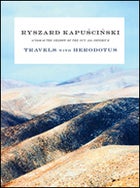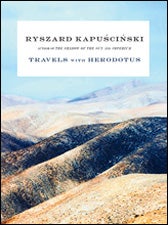REPORTS OF HIS DEATH are slightly exaggerated; Polish journalist Ryszard Kapuściński may have slipped quietly into his grave this past January, but the legendary chronicler of anarchy lives on for 275 more pages in Travels with Herodotus (Knopf, $25), a look back at half a century of journeying in the company of the fifth-century b.c. Greek historian. Or, more accurately, journeying with one tattered copy of Herodotus’s only work, The Histories, a wide-ranging inquiry into the origins of wars of antiquity and the rules of revenge and justice that govern all of humanity.
Want it? Get it
Buy,
, and
at amazon.com.
Travels with Herodotus

A foreign correspondent since the 1960s, Kapuściński reinvented hot-spot journalism in countries like China, Honduras, and Iran, surviving on a daily diet of coups d’état and revolutions while asking the deepest questions about power and ambition. Throughout his career, the daring Pole explains in this memoir, originally published in Poland in 2004, he relied on the wisdom of Herodotus to calm and amplify his mind. On his first, nerve-racking trip to India, in 1956, the ancient’s words prompt Kapuściński to look more carefully at the country’s system of social stratification, “a pedantically, meticulously woven fabric of roles and assignments, classifications and purposes” where a prince keeps a servant just for frosting cakes. When the Congo collapsed around him, in the 1960s, Kapuściński consoled himself at night by realizing that “the frequent eruption of gunfights, the constant danger of arrest, beatings, and death” were no worse than the darkening pages of The Histories, where mighty Persia looms over the fractured Greek city-states.
It was a brilliant bit of maneuvering that helped Kapuściński outrun fate for so long in so many of the world’s worst environments. An idol of war correspondents and wannabe travel writers everywhere, Kapuściński departs with this final gift, a call to wander widely and see deeply. He died in Warsaw, of natural causes, at age 74, just outlasting the 25,200 days that Herodotus said were due to any man.
Chasing Kangaroos: A Continent, a Scientist, and a Search for the World’s Most Extraordinary Creature
BY TIM FLANNERY
GROVE PRESS, $24
OFTEN SCIENTISTS choose an unimaginably obscure pursuit as their holy grailsequencing a mycorrhizal fungus, say, or dissecting mastodon turds. Lucky for us, Australian paleontologist Tim Flannery, author of 2005’s The Weather Makers, has gone after the kangaroo. In a fast-paced narrative that’s part memoir, part travelogue, and part biological treatise, Flannery recounts both his own unlikely evolution as a scientist (he once preferred riding a Moto Guzzi to doing research) and that of the kangaroo, which after centuries of living in the harsh outback has become one of the most efficient mammals of all time. They can eat practically any vegetation because they shelter worms in their gut to aid digestion; they can survive on very little water; and to conserve energy while hopping, their superhero leg tendons “act like the springs in pogo sticks, storing the power of each bound and releasing it to assist with the next.” In describing his three-decade search for evidence of the ‘roo’s origins, Flannery reveals much about the history of Australia’s landscape, from the Aborigines to present-day opal miners. Sadly, due mostly to habitat destruction, 20 percent of the more than 60 known kangaroo species are extinct or nearly so. “The fate of the kangaroos,” he writes, “is inextricably bound with the fate of my country.”FLORENCE WILLIAMS
Storm World: Hurricanes, Politics and the Battle Over Global Warming
BY CHRIS MOONEY
HARCOURT, $26
IN 2005’s The Republican War on Science, D.C.-based journalist Chris Mooney called out the Bush administration for silencing climate researchers. Now he delves into the debate still raging among the scientists themselves: Is global warming creating stronger, more destructive hurricanes? Storm World deftly focuses on the work of two very different men: William Gray, a data-driven hurricane forecaster and global-warming skeptic at Colorado State University, and MITbased Kerry Emanuel, a theorist and computer modeler “alarmed” about what he predicts will be a stormy 21st century. The two men’s respective camps are practically tearing each other’s eyes out in peer-reviewed journals, blogs, and Congress, and Mooney dishes up a blow-by-blow account of this chaotic scientific theater. “Scientists, like hurricanes, do extraordinary things at high wind speeds,” he writes. “Such conflicts may bring out their human side, but also inspire their very best work.” His reporting is evenhanded, but Mooney is clear that we should be concerned about hurricanes in a warmer worldthe most obvious signal of a climate going haywire. Humans, he writes, may well be “helping transform more and more hurricanes into monstrous city-smashers.” FLORENCE WILLIAMS


